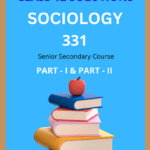NIOS Class 12 Sociology Chapter 38 Cultural Pluralism, Solutions to each chapter is provided in the list so that you can easily browse through different chapters NIOS Class 12 Sociology Chapter 38 Cultural Pluralism and select need one. NIOS Class 12 Sociology Chapter 38 Cultural Pluralism Question Answers Download PDF. NIOS Study Material of Class 12 Sociology Notes Paper 331.
NIOS Class 12 Sociology Chapter 38 Cultural Pluralism
Also, you can read the NIOS book online in these sections Solutions by Expert Teachers as per National Institute of Open Schooling (NIOS) Book guidelines. These solutions are part of NIOS All Subject Solutions. Here we have given NIOS Class 12 Sociology Chapter 38 Cultural Pluralism, NIOS Senior Secondary Course Political Science Solutions for All Chapters, You can practice these here.
Cultural Pluralism
Chapter: 38
OPTIONAL MODULE 2: CULTURE
TEXTUAL QUESTIONS
INTEXT QUESTIONS 38.1
Fill in the blanks:
(a) Pluralism means ………………… .
Ans. Many.
(b) The best example of cultural pluralism is …………….. .
Ans. India.
(c) Cultural pluralism has been termed by Pandit Nehru in his “Discovery in India” as ……………….. .
Ans. Unity in Diversity.
(d) India has been divided into …………….. states and …………… union territories.
Ans. 28 states and 7 union territories.
INTEXT QUESTIONS 38.2
Write answer in one sentence:
What do you mean by
(a) Ethnocentrism.
Ans. (a) Ethnocentrism is the tendency of judging other cultures through one’s own scale.
(b) Monogamy.
Ans; (b) Cultural relativism is an ethical position in which all cultures are taken as equal, each being a separate unit within its own integrity.
(c) Cross-cousin marriage.
Ans: (c) The example of cross cousin and parallel cousin can be given.
For example: Mr. Chaman and Mrs. Meena are brother and sister. Mr. Charan has a son of 21 years and his sister has a daughter of 18 years. They can marry. This is called cross-cousin marriage.
INTEXT QUESTIONS 38.3
Write T for true and F for false:
(a) When values regulating social life do not keep pace with changes in areas like technology, it is called cultural lag.
Ans. T (True).
(b) There are accepted international norms to regulate the use of nuclear weapons.
Ans. F (False).
TERMINAL EXERCISES
Q.1. What do you understand by cultural pluralism? Give a suitable example. (Very Imp.)
Ans. As regards cultural pluralism we understand that it is a system where different culture groups co-exist and interact without losing their respective autonomy and identity as long as they are not detrimental to the national unity and general welfare of the nation.
Example: India has cultural pluralism we find here people having pure eastern culture. There are families having pure western culture. These followers of different relizions and sets. They are having different food, dress, customs etc.
In most of the southern states of India people are having Davadion culture, having different food and diet habits, different languages and dialects and different cultural works.
Q.2. What is ethnocentrism and how does it differ from cultural relativism? Discuss with examples.
Ans. (i). The meaning of ethnocentrism, which tends to put down other people’s way of doing things as bizarre or inferior.
(ii) Cultural relativism is an ethical position in which all cultures are taken as equal, each being a separate unit within its own integrity, that should not be compared to other cultures in terms of how it measures up to their standards.
(iii) Example of ethnocentrism: Human beings live in groups. Each group has its own way of life that we broadly term as culture. Members of a group arrive at the way they conduct themselves through a continuous process of trial and error culminating in beliefs, values, mores and folk ways. Thus, each culture functions in the context of its own experience and environment. Consequently an individual looks upon his/her own culture as better than any other, and tries to judge other cultures through the standards of his own culture. This tendency of judging other cultures through one’s own scale is broadly termed as “ethnocentrism”. Ethnocentrism is perpetuated directly or indirectly, consciously or unconsciously through a process which tends to put down other people’s way of doing as bizarre or inferior. For example, cultures in which cross-cousin marriage is a norm, tends to look down upon the cultural practice in which a cross cousin is equated with a sister and vice versa.
(iv) Example of Cultural Relativism: Each culture has a history of its own, culture cannot be compared on a scale of excellence in which the ranks are set according to the standards of one particular group. Throughout our study of other cultures, we should attempt to overcome as much of our ethnocentrism as possible. We should try to become more objective about cultural differences, to be tolerant of other people. This attitude is known as cultural relativism.
Q.3. Explain cultural relativism in your own words.
Ans. It is based on the idea that all values are relative and that there are no absolute standards that are valid in all cultural settings. For example, Muslims approve polygyny which is taboo among many Hindu groups. Khasi, communities in northeast India are matrilineal whereas the Naga are patrilineal. Many South Indian communities prefer marriage with a cross-cousin, whereas in eastern India a cross cousin is equated with a sister. Muslim prefer marriage even with a parallel cousin. These practices are acceptable in terms of values in the context of their occurrence. In other words, the east Indian practice of equating a cross cousin with the sister does not hold good to judge the South Indian practice. Thus, a specific practice is related to a specific culture. This is what we mean by cultural relativism.

Chart of cross cousins.
A is B,’ husband
C is D,’ husband
B is C,’ sister
E and F are A is B,’ children.
G and H are C is and D’s children
E and F are cross cousins of G and H
One of the most fruitful discussions of cultural relativism is in the area of values and morals. We tend to be much more defensive about our moral behaviour than about other aspects of our culture because it is so strongly ingrained in us from early childhood. Our morals and values are also based on the cultural and physical environment in which we grow up and cannot be separated from it. In the context of cultural relativism: “Judgements are based on experience, and experience is interpreted by each individual in terms of his own enculturation. This holds true for all phases of culture Evaluations are relative to the cultural background out of which they arise”.
Q.4. Explain culture lag with an example.
Ans. Cultural Lag: The term culture lag refers to a situation when ideas, values, and norms and beliefs used to regulate social life do not keep pace with changes in the technology of society. For example, development of nuclear weapons by a number of nations without an acceptable international system of norms and values of regulate, control and use. In this case, a change in technology is yet to develop norms for its use. This is to say a change in values lags behind a change in the technological field.
At this moment of time, a large scale debate is going on the ethics of human cloning to produce a human individual outside the natural process of reproductive mechanism. A human individual is linked to every other individual of his/her group in a network of relationship defined by the culture of which he/she is a part. How a cloned human being would fit into this culturally defined network or social relationship is yet to develop. This is, a clear case of cultural lag where developments in medical technology have outstripped the social field.
SOME OTHER IMPORTANT QUESTIONS FOR EXAMINATION
VERY SHORT ANSWER TYPE QUESTIONS
Q.1. Who is called cross-cousin?
Ans. Cross-cousin are the children whose parents are related as brother and sister.
Q.2. What do you mean by the term “cloning”?
Ans. To create a genetic duplicate of an individual or an organism through a sexual reproduction is called cloning.
Q.3. Fill in the blanks:
(a) ……………… cousins are children whose parents are related either as brothers or as sisters.
Ans. Parallel.
(b) ……………… is a form of marriage when one man marries one women at a time.
Ans. Monogamy.
(c) When marriage takes place between one man and more than one women it is …………….. .
Ans. Polygamy.
SHORT ANSWER TYPE QUESTIONS
Q.1. What is our duty while we study different cultures or compare them?
Ans. 1. While studying different cultures and describing and comparing other cultures, we should and must remain neutral and should not make any judgement about the merits of one culture over another. Cultural relativism is an ethical position in which all cultures are taken as equal, each being a separate unit with its own integrity that should not be compared to our own
culture in terms of hos it measures up to our standards.
2. The history of each culture is distinct. Became so (that way) as a result of its own development. And, it therefore, can not be ranked against another culture with a different history. Each culture has changed over time, some more, some less in certain areas and some in response to pressures that the other did not face.

Hi! my Name is Parimal Roy. I have completed my Bachelor’s degree in Philosophy (B.A.) from Silapathar General College. Currently, I am working as an HR Manager at Dev Library. It is a website that provides study materials for students from Class 3 to 12, including SCERT and NCERT notes. It also offers resources for BA, B.Com, B.Sc, and Computer Science, along with postgraduate notes. Besides study materials, the website has novels, eBooks, health and finance articles, biographies, quotes, and more.



